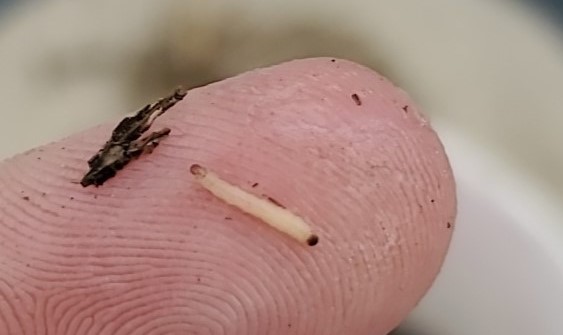July 15th, 2022
posted
by Andrew Blomme on 7/15/2022
in
Weekly Newsletter

July 15th, 2022
Corn Rootworm Pressure
The past 2 weeks, I have made it a priority to scout for corn rootworm in the area. Corn rootworm is the single greatest yield robbing insect that we face every year. We can gauge rootworm pressure by digging up corn rootballs and conducting a float test. A float test is where you submerge a rootball in water and the rootworm larva in the soil float to the top to be counted. Rootworm counts of 5-6 larva/plant are levels where rootworm is likely causing yield robbing damage. Below is a picture of a rootworm larva I found this week.

I floated rootballs on several corn on corn fields that were the rootworm "hot spots" last year. The average number of rootworm I found across all the fields were 3-4 larva/plant. The highest count I found was 7 per plant. For reference, last year, in comparable fields, I found 15+ rootworm/plant.
Last year we had record rootworm numbers in our area. This year we are seeing lower numbers and there are several reasons for that. The first reason is that we dramatic decreased adult beetle populations last July by throwing in an insecticide with the fungicide pass on the majority of these high pressure fields. Fewer adult beetles last year means less eggs laid last fall and less larva this year. In the same way, the more we control rootworm beetles this year the less pressure we will see next year.
Fungicide Applications Start Next Week
Earlier in June, I predicted that we would start to see tassels on July 9th or 10th. I was wrong, I saw the first tassels peeking through on the 8th. Now, a week later, we can find whole fields quickly approaching the VT stage, the optimal time to spray fungicide on corn.
I've had several people ask why we spray fungicides at VT (Tassel) and not sooner or later. There are a couple reasons for this, but I am going to focus on the 2 basic principles that I think are most important.
Firstly, VT is the first time that all the leaves of the corn plant are unfurled and open. Those leaves are our targets for this application. Fungicides are meant to protect the corn leaves from diseases, and we want to especially protect the leaves from the ear and up. If we had applied a fungicide two week ago for example, the top 5-6 leaves of corn plant would still be curled up in the whorl and wouldn't benefit from the fungicide. It is very important to protect the top section of a corn plant because that is the section of the plant that will be photosynthesizing the most over the next 2 months.
The second reason that we apply fungicides at VT is because of disease development timing. Much like it is easier to control a waterhemp plant when it is 2" tall compared to 12" tall, fungicides are most effective at controlling leaf diseases early on in the disease's development. Once the disease has manifested on the leaf it limits the photosynthetic productivity of that leaf and is markedly harder to control for an extended duration.
The picture below shows a gray leaf spot lesion that is about 1/8" long. We will get a bigger yield response by controlling it now compared to when it is several inches long and spread across the whole leaf. "An ounce of prevention is worth a pound of cure," Ben Franklin said this about medicine but I think it is pretty applicable to this concept too.

If you are planning on spraying fungicide make it a priority to reach out to Mike if you haven't already. There are a lot of acres to cover and we need to be as efficient as possible to get to every field timely.